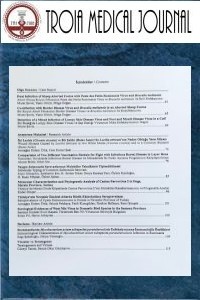Indications and Outcomes of Esophagogastroduodenoscopy in Children
SummaryObjective: Esophagogastroduodenoscopy (EGD) has become a key element in the diagnosis and treatment of many gastrointestinal diseases affecting children. In this study, we aimed to discuss endoscopic indications, endoscopic and pathological findings of children who underwent EGD in our hospital.Methods: A retrospective chart review of children between1-18 years old who admitted the pediatric gastroenterology department between 2017 and 2018 and who underwent EGD was performed. EGD indications, diagnoses made by endoscopy or pathological examination, and complaints were evaluated.Results: A total of 194 children (85 male and 109 female) with a mean age of 10.63 ± 4.84 years were included in the study. Dyspepsia (66.49%), suspicion of celiac disease (19.59%), intake of corrosive material (8.25%), gastrointestinal bleeding (4.64%), and dysphagia (1.03%) were the main complaints of referral. The distribution of the diagnosis of the participants after EGD was antral gastritis (48.45%), pangastritis (21.13%), duodenitis (11.86%), celiac disease (7.73%), acute ulcer at bulbus (1.55%) and esophagitis (1.03%). Of those, 9.28% were healthy. A biopsy was obtained in 88.66% of the subjects during EGD.Conclusion: Dyspeptic symptoms and suspicion of celiac disease are the most common EGD indication in children. Alkaline reflux, gastritis, and helicobacter pylori infection affect the degree of pathological inflammation and require appropriate treatment and follow-up. Keywords: Endoscopy, Child, Esophagus, Stomach, Duodenum
___
- 1. North American Society for Pediatric Gastroenterology, Hepatology and Nutrition: pediatric gastroenterology workforce survey, 2003–2004. J Pediatr Gastroenterol Nutr. 2005;40:397–405.
- 2. Gilger MA. Gastroenterologic endoscopy in children: past, present, and future. Curr Opin Pediatr. 2001;13:429–34.
- 3. Franciosi JP, Fiorino K, Ruchelli E, Shults J, Spergel J, Liacouras CA et al. Changing indications for esophagogastroduodenoscopy in children during a 20-year period. J Pediatr Gastroenterol Nutr. 2010;51:443–7.
- 4. Sheiko MA, Feinstein JA, Capocelli KE, Kramer RE. Diagnostic yield of EGD in children: a retrospective single-center study of 1000 cases. Gastrointest Endosc. 2013;78:47–54.
- 5. Fox VL. Pediatric endoscopy. Gastrointest Endosc Clin N Am. 2000;10:175–94.
- 6. Backeljauw B, Holland SK, Altaye M, Loepke AW. Cognition and brain structure following early childhood surgery with anesthesia. Pediatrics. 2015;136:e1–12.
- 7. Durakbaşa ÇU. Interventional esophagogastroduodenoscopy procedures performed in the upper digestive system in children. Çocuk Cerrahisi Dergisi 2016;30:170-180.
- 8. Nguyen VX, Nguyen VT, Nguyen CC. Appropriate use of endoscopy in the diagnosis and treatment of gastrointestinal diseases: up-to-date indications for primary care providers. Int J Gen Med 2010;1:345-357
- 9. Işık, İshak A. Sedation practices in pediatric gastrointestinal endoscopy and related consequences (Yandal uzmanlık tezi). İzmir, Dokuz Eylül Üniversitesi, 2012.
- 10. Isik IA, Iyilikçi L, Ozturk Y, Adiyaman E. Sedation Practice Outside the Operating Room for Pediatric Gastrointestinal Endoscopy. Indian Pediatr. 2015;52:989-90. 11. Uğraş M, Alan S. Evaluation of The Results of Pediatric Upper Gastrointestinal Endoscopies. F.Ü.Sağ.Bil.Tıp Derg. 2012;26:31-34
- 12. Fasano A. Where have all the American celiacs gone? Acta Paediatr Suppl 1996;412:20–4.
- 13. Fasano A, Berti I, Gerarduzzi T, Not T, Colletti RB, Drago S et al. Prevalence of celiac disease in at-risk and not-at-risk groups in the United States: a large multicenter study. Arch Intern Med 2003;163:286-92.
- 14. Suerbaum S, Michetti P. Helicobacter pylori infection. N Engl JMed 2002;347:1175-86
- 15. Malaty HM. Epidemiology of Helicobacter pylori infection. Best Pract Res Clin Gastroenterol 2007;21:205-14
- 16. Özden A, Dumlu Ş, Dönderici Ö, Çetinkaya H, Soylu K, Özkan H et al. Helicobacter pylori infeksiyonunun ülkemizde seroepidemiyolojisi. Gastroen teroloji 1992;4:665-8.
- 17. Fukuhara K, Osugi H, Takada N,Takemura M, Lee S, Taguchi S et al. Correlation between duodenogastric reflux and remnant gastritis after distal gastrectomy. Hepatogastroenterology. 2004,51:1241-1244.
- 18. Feldman M, Edward LL. “Gastritis‘‘ in Sleisenger and Fordtran’s Gastrointestinal and Liver Disease. Pathophysiology/Diagnosis/Management, M. Feldman, S. F. Lawrence, andJ. B. Lawrence, Eds., pp.880-881, Saunders, Philadelphia, Pa ,USA, 10th edition, 2015.
- ISSN: 2630-6107
- Yayın Aralığı: Yılda 3 Sayı
- Başlangıç: 2019
- Yayıncı: Çanakkale Onsekiz Mart Üniversitesi
Sayıdaki Diğer Makaleler
KOAH'DA UNUTULAN ELEMENT; FOSFOR
Pınar MUTLU, Merve İ. GÜVEN, Özgür ÖZERDOĞAN, N. Arzu MİRİCİ
Meryem KEÇELİ BAŞARAN, Yılmaz SEÇİLMİŞ, Nur Şeyma ZENGİN
KOAH'DA UNUTULAN ELEMENT; FOSFOR
Pınar MUTLU, Merve İ. GÜVEN, Özgür ÖZERDOĞAN, N. Arzu MİRİCİ
Important Pathology In The Differential Diagnosis of Crohn's Disease: Tuberculosis Ileocolitis
Uğur ERGÜN, Gülhan Zorgör UÇDU, Ahmet ÜRK, Merve Nur AK, Erkan ÇAĞLAR
Yunus TAN, Erkan Melih ŞAHİN, Fatih YURDAKUL, Huriye ÇETİN
Important Pathology In The Differential Diagnosis of Crohn's Disease: Tuberculosis Ileocolitis
Uğur ERGÜN, Gülhan Zorgör UÇDU, Ahmet ÜRK, Merve Nur AK, Erkan ÇAĞLAR
